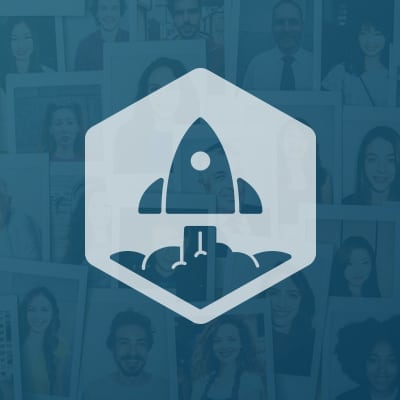Jason Lemkin sits down with Stripe COO Claire Hughes-Johnson to discuss what it’s like to scale a fast-growing company and how to manage hypergrowth. Having over 10 years of experience with Google and being intrinsically motivated by Stripe’s mission certainly helps.
When you’re the COO of a global company that only continues to expand across borders, you need to make sure that you’re hiring the right people. But whether you hire globally or domestically, the key is achieving true retention among employees.
Listen on to discover what Claire has to say about the sales function within a company, how to get the word about your product out into the market and what’s got her excited about Stripe’s future.
And if you haven’t heard: SaaStr Annual will be back in 2021, bigger and better than ever! Join 10,000 fellow founders, investors and execs for 3 days of unparalleled networking and epic learnings from SaaS legends like Jyoti Bansal, Dustin Moskovitz, Jeff Lawson, and Michael Pryor. If you don’t have tickets, lock in Early Bird pricing today and bring your team from just $749! (All ticket prices go up September 1st.) Get tickets here.
TRANSCRIPT
Jason Lemkin: Thanks for coming.
Claire Hughes Johnson: It’s great to be here.
Jason: There’s a lot I want to chat about, but we were having a discussion backstage. Raise your hand if you’ve not heard of Stripe just I can know how we can do the first five minutes. Anyone not heard of…? OK. One, two…
Claire: Jason said it would be six people.
Jason: What’s that?
Claire: You said six.
Jason: Six people. We just wanted to make sure we framed the audience right. There’s a lot of stuff I want to chat about.
Let’s chat about it. Tell us about Stripe. What do you do, and where you’re at today? Then we’ll dig into some interesting stuff.
[crosstalk]
Claire: First of all, thanks for having me. Great to see everybody. If you’re not from San Francisco, welcome.
Stripe is a set of developer tools for building and operating an online business. We work with hundreds of thousands of companies around the world on accepting payments, expanding globally, and increasingly, on innovating their business models for the Internet and for mobile.
It’s relevant to the SaaS audience because it’s easy to underestimate how complicated a SaaS model gets with the number of billing plans, the number of custom fees and prices you want to add in.
We’ve increasingly worked to build solutions that you can just integrate with us and spend your time building the rest of your product. That’s what we do.
Jason: Let’s chat about a few things. Stripe’s, what? 500, 600 people today, something like that.
Claire: We’re a little over 600 people today.
Jason: Six hundred people. You joined as COO, how long ago, 18 months, 19 months?
Claire: Two and a half years ago.
Jason: Two and a half…How big was Stripe then?
Claire: We were about 170.
Jason: A hundred and seventy. Everyone in the room wants to hire a COO. I can guarantee you there’s almost no one here that’s pre revenue. It’s everyone’s dream. A couple of things, then let’s dig in.
Why’d you join? What got you to join? How did they convince you to join?
Claire: This is a good thing to think about because there’s a set of things which are personal to me. My criteria, my career ambitions. Then there’s a set of things that Stripe brought to the table, that were so compelling that I couldn’t, in the end, walk away from it.
On the personal side, it’s incredibly important to me that my next step be a company whose product and mission I really believed in.
A lot of the time I spent with John and Patrick in the interview process was understanding their vision for the company and the fact that this is a developer tools company.
It’s also about economic access. It’s about building economic infrastructure for the Internet. Still, less than five percent of consumers purchasing is happening online which seems shocking.
If you want to build a company in certain countries in the world, it is so hard just to accept payments. Then it is so hard to get into multiple markets. Even Google when I was there, this was one of the biggest struggles we had.
The billing and payments team was a roadblock to launching our products in markets.
Jason: You already had the visceral pain of…
Claire: I saw an opportunity for an impact, yes. There’s a mission there that, frankly, the founding team, the people you’re going to work with all day long.
When you’re building a company, you are working hard, and you’ve got to be aligned. The third part for me was the people I met in the company, the culture that was being built, the DNA. Then the product market fit.
Just starting to see the numbers and seeing, “Hey, I could have an impact here. I could have a chance to be part of building something.
Jason: That was still, remind us, that was 26 months ago you said, something like that?
Claire: Yeah. That was about two and a half years ago.
Jason: How crazy different is Stripe today versus then?
Claire: In some ways, it’s not so different. Some employees might disagree with me, but I actually think one of my philosophies on scale is, there are things you’re building which are like an organizational system.
Organizational systems tend to vacillate between chaos and bureaucracy. Early systems tend to be more chaotic.
The reality is if you build a strong axis on which that turns and evolves, every new person you add to your company is changing your organizational system, and you’re changing the way you do things.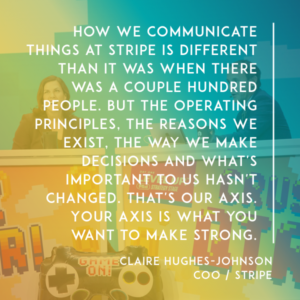
How we communicate things at Stripe is different than it was when there was a couple hundred people. But the operating principles, the reasons we exist, the way we make decisions and what’s important to us hasn’t changed. That’s our axis. That’s what you want to make strong.
Jason: How was the company infrastructure when you joined? Was it a startup crazy mess, or was it fairly well organized? What kind of rigor were you able to bring to the company in the beginning that helped fuel hyper growth?
Claire: What actually surprised me the most was how complicated the business was already, given it was only about 170 people.
If you think about the work we do on the developer side, the engineering innovation, the industry, all the payments partnerships around the world to build our stack, it actually amazed me how many teams had started to grow and evolve already.
There were some things that needed more, and actually a lot of scaling, I don’t think is hiring per say. You’re looking at your user base numbers and they’re going like this, and hopefully your revenue numbers are going like that, you have an obligation to that user base to build the right infrastructure for them.
A lot of where I focused my energy was on the go to market piece, the sales organization, and also the internal recruiting piece. How are we going assess what things we did need to build, and then find the right people and be able to add the numbers without upsetting that culture?
Jason: Let’s talk about those two things. If we had infinite time, we could fill it all up just with those topics.
You joined Stripe at 100 and some odd employees. What did go to market mean when you joined and what changed?
I view Stripe as having a huge brand today, but maybe you think it is a 600 person company with five percent penetration. How strong was the brand then? What did go to market mean then versus now?
Claire: There’s a classic way to think about building the funnel. I actually had a lot to learn joining Stripe about the developer-out model. A lot of how the brand was built and what was important to the company, and is still important to us today, is staying true to the developer audience.
A lot of the virality of that was developer to developer communication. Occasionally, Stripe folks participate in IRC, Hacker News, and some of those forums, but we actually have an expression internally, which is the Collison Installation, which is one of the founders would often go in and sit in with our users and really understand how the product was working for them and evolve from there.
A lot of the early branding was about staying really true to the user base. When I came in, we had a ton…You may or may not know, but Stripe has a ton of self service. You’re going in. We’ve got great documentation.
You integrate the API. With a couple lines of code, you’re in 25 countries. That is pretty easy, and actually a lot of people do it and start testing our product without us ever talking to them.
We did increasingly have a lot of inbound demand. The first go to market step actually…
Jason: Inbound, “Contact me,” or what is it then?
Claire: Inbound, “We want to use your product, but we’ve got some questions.”
Jason: “Please call me.”
Claire: “We’ve got some questions. Please call me. Please answer my questions.”
We didn’t, at that point then, need marketing, because we had to get on top of that inbound demand. It’s a good problem to have.
One of the reasons we had that is because payments is so critical in the early stage when you’re getting ready to do that that people were coming to us. We’re lucky to have that reputation. Our technical excellence is what built that reputation.
The first thing I did was get on top of the inbound demand, which is, “What are the kinds of people we need?” We needed a really technical sales type of person who is super agile, able to adapt with a really rapidly changing product.
I was lucky enough to start to bring in the right folks who could build that.
Jason: Let’s break that down a minute. You come in and there’s already some change. In the early days, are these quota carrying folks, or are you still on this loosey goosey, happiness officer, “Do your best”?
I’ve invested and worked with a lot of developers and/or companies. You don’t want to break that culture.
Claire: You don’t, absolutely.
Jason: You break it, and it’s gone. As soon as you break that, the trust is gone. The trust is gone forever anywhere, right?
Claire: Yeah.
Jason: Sometimes, I wonder whether happiness officers are the perfect solution either.
Claire: I definitely have never called myself the happiness officer. Please don’t let me do that.
Jason: That is a very teal term. That has got around a lot lately. I get they’re developer centric sales folks.
Claire: Initially, to your question about quota carrying, that wouldn’t have been culturally appropriate.
Jason: Tough quick change, right?
Claire: It didn’t make sense. Quite frankly, when you’re in that hyper growth, your ability to predict, forecast, and set reasonable targets is not actually that easy. It’s unfair to the company and the salesforce to be guessing at what reasonable targets are.
You get these externalities of bad behavior that aren’t really what you’re looking for at that stage. Actually, we did something that I think was clever, and you can decide, which is we did start to hire people on a sales compensation plan, but we have been paying them mostly on target.
They understood that. They understood there was a long timeline to get to the position when the variable comp would start to kick in, but you also have a problem if you build a big salesforce and then try to switch them over to a more variable compensation. You’re clawing back expectations about their cash flow.
Jason: It is…
[crosstalk]
Claire: We do pay our sales folks quarterly so that they’re used to that. They’re ready for it.
Jason: Today, as you’re scaling, you’re still relatively small, certainly by Google scale. Do these folks still need to be as technical to do sales because this is always a challenge?
You watch what GitHub went through and other folks. At some point, every sales rep can’t be a hacker or a want to be engineer, right?
Claire: Yeah.
Jason: Have you reached that phase, or it’s not important yet?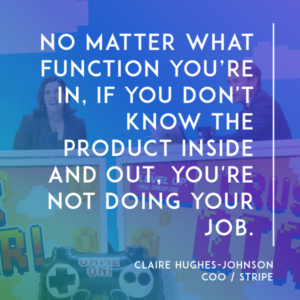
Claire: One of the most important things to me in building any function that’s not an engineering function in the company is if you don’t know the product inside and out, you’re not doing your job.
Jason: Absolutely.
Claire: There’s an element of technical ability and knowledge that will always be in our salesforce, or else I’m not doing my job. To your point, if you think about Stripe’s user base, it’s really diversified.
We’ve got developers.
Jason: Regular people.
Claire: We’ve got early stage folks. We’ve got bigger companies. We have companies that are scaling like Slack, Lyft, Kickstarter. They’re our users. We’ve got partnerships with Macy’s. We’ve done work with Twitter and Facebook. We’ve got this huge range.
The thing that we have started to look at is a team that I call Field Engineering, which is a technical asset. We have very few of them. We’re not going to throw them…I don’t like that model of the salesperson comes in with the sales engineer.
Jason: With the sales engineer.
[laughter]
Claire: They don’t know the product.
Jason: What’s the answer to that question?
Claire: Yeah, that’s just not great.
Jason: That’s horrible.
Claire: They’re asking this person to demo. The person comes in, and the person who’s demoing the product is the one who actually knows the product. Why is the salesperson sitting there?
That’s not what we’re going for, but we’ve found that some of the larger more enterprise type users that we’ve started to talk to expect more in the onboarding. They want a contact that’s helping them do the work. We’re starting to satisfy that.
Jason: You even go on site? Have you gotten to that level? You’ll go?
Claire: We’ll visit with them. [laughs]
Jason: How much, because that’s another transition for a developer focused companies, right? You can start off and never meet a customer if you don’t want to, right?
Claire: Yeah.
Jason: Even if Patrick and John did meet ups and stuff like that, you literally…Do you want to meet all your bigger customers? How do you think about that at this stage?
Let me put it differently. How is your relationship with the customers changed since you started?
Claire: That’s actually back to the point about the developer audience, but it’s really in the DNA of the company to know the user base. Our initial engineers, all did customer support. That was part of their…
Jason: I love it.
Claire: That was part of their job.
[crosstalk]
Jason: …they hated me for it.
Claire: A few of them actually moved over to help start that team, which was amazing. Patrick and John have always…
Jason: How long does that last?
Claire: How long does that last?
Jason: Do you make engineers do customer support forever?
Claire: What we do today is we give them all an account so they can go in. We have company events where we ask people to go in and handle user issues. It’s actually pretty popular, but they do like to have someone from our user operations [laughs] team with them because it gets complicated.
Jason: It doesn’t scale forever.
Claire: It’s actually really good learning for an engineer. You’d be surprised at what users need and that explaining the product to them is a different challenge.
Back to your point, Patrick and John have always spent time with our users. Actually, everyone on the leadership team does. One of the things we do periodically is look across our user base, and talk about the relationships we have with increasingly our top users, but frankly, it’s really encouraged.
Patrick and John go in and do the user cases. They’re still in there, which is an example to everyone. It’s the kind of company I want to be at because you wouldn’t exist without those users. So if you’re not talking to them, you’re not in good shape.
We have built more dedicated teams, so the larger users, to your question, “How has it changed?” That was another change that we put in place when I came in, which is you start to respect that those users are at really different stages.
There are certain stages we’re seeing where we need to provide more dedicated account management basically.
Jason: On the go to market, before we move onto the next topic, I want to pick up on one thing you said. You come in, and join. It’s a lead rich environment, right?
Claire: Yeah.
Jason: First thing you do is you build a technical sales organization that can…You pick someone up. They can answer the phone. They can talk to customer.
Claire: Yeah.
Jason: When you’re in a lead rich environment like that, and you have an evolving brand, how do you think about marketing? What is marketing’s job over those 25 months?
Claire: Again, we’re really lucky that we have founders who go out and talk to the market a lot, which is…
Jason: There’s no lack of the founder PR stuff.
Claire: There’s a lot of good communication that comes from that. That helps with the lead volume. The way we started to think about marketing was in two ways.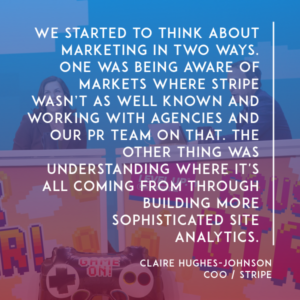
One was being aware of markets where we might not be as well known and working initially with agencies and working through our PR team on, “How do we develop more of that understanding?” The best way to do it for us, back to the beginning of this story, was working though the startup ecosystem.
Spending time with developers, spending time with incubators, VCs, what have you.
Jason: Go there.
Claire: Go there. We’re in those markets. We’re in 25 countries now. We’ve got teams around the world, which is something I’ve been working on building out. We go back to our roots to build that market knowledge.
The other thing on marketing is understanding where it’s all coming from. You’ve got to start to build more sophisticated site analytics. We can use some of our users’ products, like Tableau and Mixpanel, and what have you.
Those are SaaS Stripe users, and they’re also products that we like to use so we can track where the leads coming from, how are they converting, get a better awareness before you start throwing marketing at it.
What’s working today is a good place to start.
Jason: It is a good point. There’s a couple of things I want to make sure we hit, but let’s talk about the second one on your list which was recruiting and team building.
What are the learnings? What have you done? What have you changed at Stripe? How have you helped? It’s Level Up Day. What are the learnings for Level Up? What are your tips and tricks for folks here for building the team?
Claire: Early on, you probably got your founders and engineers doing your recruiting, right?
Jason: Yeah.
Claire: That’s your core team.
Jason: You do it yourself.
Claire: You do it yourself.
Jason: The rest of your job.
Claire: You actually come up with very true to your company ways of doing that. Our engineering interview process was built by our engineers. That’s exactly how it should be done, right?
Jason: Yes, I read it on Quora.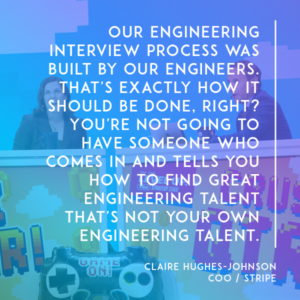
Claire: You’re not going to have someone who comes in and tells you how to find great engineering talent that’s not your own engineering talent. The key to me was to take those assets and start to build internal understanding that you actually do need a recruiting organization.
We had a couple of recruiters, but we needed to get much more intentional about where we wanted to grow the company and what we could do to augment the assets we already have.
A lot of how we do it today is still very all company driven. People know that they have a role in it. They know that they’re part of the hiring process, but they do have recruiters they can lean on and help them through.
It’s like program management for recruiting, but you’ve got build it because there’s a point when you’re looking…Talk about Level Up, there’s a step function in your hiring that you can’t go from onesy, twosy up to…If you’re going to double your company in a year, you’re going to need people who focus on that full time.
Jason: You do.
Claire: You do. I believe you do.
Jason: In every company. Today, I don’t even know, are there a lot of layered titles at Stripe, or is that just like…?
Claire: No.
Jason: My guess is there’s not a lot them.
Claire: No.
Jason: There’s still team leads. There have to be that are in charge of recruiting, right?
Claire: We have a head of recruiting. We have some managers.
Jason: The managers, because it’s a learning for a lot of folks here, you’ve got a double next to your headcount or some crazy number, right?
Claire: I think more about, “How’s the business growing?”
Jason: Sure.
Claire: I think, “OK, what do we need…?”
Jason: Let me…sorry. Not to get…
Claire: We’re trying not to double, but say you have to double.
Jason: How do you coach folks to build these teams? You teach them how to bring in recruiters. A lot of founders find recruiters frustrating learning, in terms of, “What do I expect of an internal recruiter? How much work? How will they source candidates? How much does my team have to do it?”
What’s the balance? Is there any help you brought in there? What are the learnings?
Claire: The main learning is back to this partnership. We actually, and our recruiters learn this as they come in, and some of them have been in other companies that had the factory recruiting model is what I call it where it’s like…
Jason: Google had a real machine there, didn’t it?
Claire: Google, over time, built a very big machine, but actually I would say there was a point when it flipped into, “We’ll just take care of that for you if you’re a leader at Google?”
[crosstalk]
Jason: They’ll take care of that for you.
Claire: I’m not a believer in that model. I understand though. The empathetic part of me would tell you, “If you’re trying to grow to 60,000 people in that short amount of time, you do have to build a machine.”
But I think the right model is what we do is we do a meeting when we’re creating a new role. The hiring manger, which could be a manager or a people manager or not actually, but the hiring manager helps write the job description.
They help write the interview framework. They help meet with the group that’s going to be interviewing the candidate.
We come up with the rubric, the assessment together. They are part of the whole process. The recruiter is much more than informed. They even look at profiles like, “Does this profile look right?” You’ve got to get honed in on what you’re looking for because if you don’t, you’re going to burn a lot of candidates through trying to figure out what you want.
Jason: Burn a lot of candidates. Do you find that, when you have a brand like Stripe, it actually in some ways can be a detriment because you get so many tire kickers that they’ll always take an interview, won’t they, or maybe it’s not a known issue?
Claire: We’re very lucky that we have a lot of inbound job applicants.
Jason: A lot of inbound job applicants.
Claire: It is a lot of work. This is something the recruiting team does very well, which is they’re going through making sure those applicants have a good experience and screening them and helping us find the folks that we think should come in and meet us. I’m actually going to go with it’s a good problem to have.
Jason: It is a good problem to have.
Claire: I feel lucky that people want to work at Stripe.
Jason: In the market today, what are any tips you thought through on retention because especially in engineering it can be fatty? There are a handful of folks that occasionally leave after their cliff. Like besides culture, any learnings you’ve done because I’m sure you think about retention a lot. There’s no point in recruiting if you don’t have high retention.
Claire: Yeah, and we do think about it. I feel like retention is one of these things where you look at two buckets. One is extrinsically are people feeling compensated fairly. Are you competitive with the market?
I think that’s less important for the true retention. I’m just going to argue which is, are you hiring people who are intrinsically motivated? Look back at the first answer I gave you. I joined this company because I believe we’re doing something very important.
Jason: You did.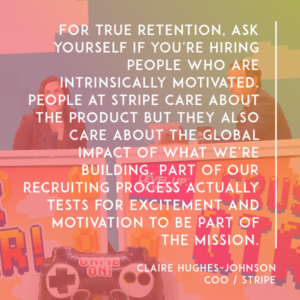
Claire: You’ll find a lot of engineers and people in the company, yeah, sure they care about the product we’re building, but they care about the global impact of what we’re building. I think part of our recruiting process actually tests for excitement and motivation to be part of that mission.
Our job once they’re in the door is to keep them involved and keep employees on the same page about why are we doing this. What is their role in it? I always say to people, “I run a spin up.” When new Stripes join us, we have an onboarding program which I really recommend.
If you’re a founder, you want to be part of that onboarding program. If you are leader in the company, you should be part of it. It’s your chance to talk and imprint like, “This is what’s important to us as a company.”
I do one where I say to the folks in the room, if any of you at any moment doesn’t know how the work you do every day directly connects to what we’re trying to do in terms of mission, then I want you to come talk to me because then you’re not in the right job or we’re not doing our job.
I think there’s a lot of that engagement when you’re there, and why people are there, and keeping them included. I think that’s when companies go through this weird thing where there’s some exogenous force that is somehow the executive team. No, you’re all in it together.
Jason: That’s one of the biggest risks of scaling.
Claire: I think it’s one of the biggest risks.
Jason: As soon as they become the other guys, the folk.
Claire: You are in it together. Any issue we have internally and we’re very transparent. We do employee engagement survey which I did bring in to the company. We share all the results and we talk about what can we do differently if there are things where people are unhappy. It’s all of our problem.
Jason: That’s good. That is super important.
There’s a couple of things I want to hit before we leave it. Some of the stuff you talked about on internationalization and going global. First of all, even with 500 employees, how do you handle all these countries?
Claire: I love it.
Jason: You love it?
Claire: [laughs] Yeah, I do. I love it. Actually I think one of the things I say to people is, scaling the US at the same time that you’re scaling around the world, first of all, is part of our proposition.
Jason: It’s part of the proposition.
Claire: That is what we’re offering to all of US users…
Jason: It’s part of the secret sauce too or the secret sauce.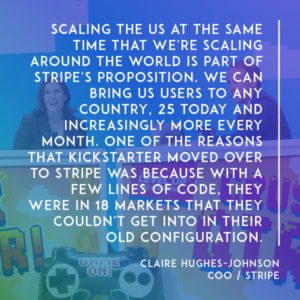
Claire: …is we can bring you to any country, 25 today increasingly more every month. I think one of the reasons that Kickstarter moved over to Stripe after they’d already started scaling was because with a few lines of code, they were in 18 markets that they couldn’t get into in their old configuration. It’s part of why we exist.
Jason: It’s a different solution.
Claire: It’s a kind of different solution.
Jason: It’s a different solution.
Claire: How do you handle it? You hire really, really well because these folks on the ground building the country team are your company in that country.
Jason: You’re country by country?
Claire: Yeah. We basically have clusters of markets, and so we have folks we’ve hired in some key locations like London, Paris, Berlin, Melbourne. They’re building around them teams that can handle that. Increasingly it will become a region, but right now its clusters of markets. I spend a ton of time with them.
That is one part of what I think is the most important part of my job is to be them connecting to what’s happening here and me transmitting back what they’re experiencing and what their needs are. Some of those leaders come to San Francisco once a quarter and we do like a lot of time together both with product, engineering with me.
What’s our strategy? How are we scaling because I think the other thing that happens to the company is they start to like…you’re not actually being consistent with your go to market.
Jason: It is very hard.
Claire: It’s very hard. You’ve got to keep those people close. What are the things we’re going to do that are similar? What are the metrics that matter? That’s how you’re going to be measured? Where can you experiment, because they also want to have autonomy? I spend a lot of time on that.
Jason: In an API centric company, what is their job? What are their goals or KPIs? You could serve them from here all speaking native languages. That has been done before.
Claire: Yeah, that has been done before.
Jason: There are companies that speak every language on the planet, but they decide to get together in one time zone. It sounds crazy, but there’s examples all over.
Claire: No. There are examples of that. Again we think of ourselves as a global company. We believe having an on the ground presence in pretty critical. I would go back to my comment about the developer community. The startup ecosystem in that market needing someone they know at Stripe.
The folks who are leading in those countries are spending a certain amount of time on that work, which is market building work I think for us. A certain amount of time on the media, the government, the policy piece starts to get more important as you scale.
Jason: That is important.
Claire: They have a sales responsibility. They have a revenue responsibility. So their key metrics are on… For us, it’s our payment volume and our margin. We look at it together every quarter. I’m very transparent. You know your numbers. You show them in front of your colleagues and you talk about what’s working and what’s not working.
Jason: [laughs] They do have a revenue commit in each of these regions?
Claire: They do. They take it very seriously because really to them it’s just an indicator of we’re building the market.
Jason: When you go international, my limited experience is there’s… To make it overly binary, you can have folks that own a number and you can have folks that basically own customer happiness, customer satisfaction.
Claire: They do spend time with existing users.
Jason: They’re both important. If you have a revenue focused team, they’re going to get you more revenue. If you have a customer happiness, CSAT, NPS, whatever they’re going to be more like customer support. You just get different outputs based on what you incent. Maybe you haven’t experienced that, but they do have revenue growth.
Claire: No, I’ve definitely experienced that. It’s like the difference between recruiting and HR.
Jason: It is.
Claire: They’re existing users and growing user base. The way we’ve achieved that is more the teams under them. They have a responsibility to think across the entire revenue set which for us is we have a lot of users that are just staying with Stripe and growing an existing user base.
If you don’t add new on top of that, you’re going to hurt yourself three years down the line.
Jason: You’re going to hurt yourself.
Claire: They really have to pay attention to the existing user base and the sales, but the people under them or in hubs like in Dublin, their roles are divided between more of a customer success, we don’t call it that…
Jason: It’s a bigger teal.
Claire: …and then a new business role.
Jason: One topic I want to make sure we get so we’re on a timeline…
Claire: We’re really in the nitty gritty here. I hope this is helpful.
[laughter]
Jason: This is SaaStr. That’s where we will learn on how to scale.
We want to learn how to scale. When you talk about the Kickstarter example of why they switched from a homegrown solution or whatever, because of the 21 country support.
Claire: 25.
Jason: What’s that? 25?
Claire: 25. But it was 18 at the time.
Jason: It was 18 at the time. In your tenure at Stripe, talk about how it’s become a more important product, a bigger…
We talk about tools versus solutions. Whatever they used before was fine. It might have been worse, but I assume it’s a switch for Kickstarter.
Listen, I’ve got to be in 18 countries tomorrow. I don’t care if my tool, if my existing payment gateway, which we hacked together and it was terrible, but it’s six years old and it works. All of a sudden, you solve a problem for me.
I want to be…Kickstarter’s got to be. I’m sure that’s one of a few examples of how you’ve become more of a bigger solution and even more enterprise.
Claire: There’s two models of how we’ve evolved that way. One is the company in an earlier stage that is using our suite of tools and increasingly that suite is more interesting to them. If you think about multiplan subscriptions, which we just launched. That’s really interesting if you’re a SaaS business.
You can use our subscription logic…
Jason: It’s a problem everyone has here.
Claire: Everyone here has that. It would be nice if someone gave me some of out of the box logic. You can play around with that as you scale.
We’re building solutions for marketplace businesses, too. You think about business like Lyft, Instacart. They have multiparty payments which are actually very hard to do from a logistical point of view but also from a compliance point of view.
You want the reporting back to your finance team to be very clean. There’s a set of businesses that have an Internet new business model, Kickstarter’s a good example, that are looking for a solution that meets them, not just on the payments front, but on the tools they’re going to need to actually scale that business and scale it internationally, is one of them.
The other is what you’re getting at, which is the enterprise piece, and I have a lot of conversations with CFOs. Usually, we’re talking to the engineering team at a company, but sometimes now we’re talking to the CFO.
Jason: That’s a big evolution over time, isn’t it?
Claire: That’s a big evolution. One of my favorite conversations is one I had late last year with a CFO. They had acquired a few companies, and the companies they acquired were on Stripe.
He wanted to get on the phone with us, he’s like, “What are you, and why do I have this problem now where I’ve got these other companies in my orbit on Stripe?”
He said, “And I’ve got this product manager who’s telling me he can’t launch our mobile product without using Stripe,” because their internal billing and payments team was constraining this guy’s new initiative, which was to sell their product on.
I explained Stripe, [laughs] and he said, “OK, I’m hearing two things from you. One is, I have a business problem, which is I can’t launch my mobile product with speed, and you can solve it.”
The thing, that hadn’t occurred to me is, I have a business opportunity which is, we’re a much more agile solution for them than this legacy system where you’ve got…My experience in the past is, engineers who are at a company whose core product isn’t working on billing and payments systems don’t want to work on them.
He’s like, “I could free up those resources and move over to Stripe and also be able to play around through the API with the different business models,” which they’d been…they’re wrapped around the axle on one thing right now.
We’ve had a continued conversation because that’s a big switch, which is to say, “I’m going to take this legacy approach and I’m going to move through an API to do that core piece of business functionality.”
Jason: It is a big switch.
Claire: It’s increasingly happening, for the global reason and for the agility reason.
Jason: You’ll have a Lyft that all of a sudden becomes a huge customer, like magic, I assume, the example that you’re talking about, these more traditional companies require more traditional…you’re talking with the CFO, how does that change the team or the dynamics in any particular way?
Is it the same? Same sales team, same everything team or does Macy’s have the same needs as Lyft?
Claire: No, they definitely don’t have the same needs, [laughs] which is fun. It makes our job fun.
Jason: It is fun.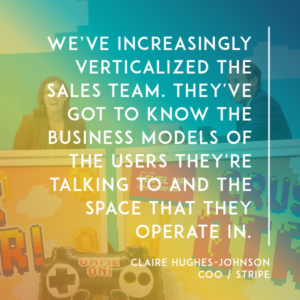
Claire: We increasingly have verticalized the sales team. They’ve got to know the users business models that they’re talking to, the space that they operate in. We have hired more of a range of experience, I guess, in sales.
This fits with our DNA. A lot of leaders, me included, and our sales managers are out talking to the larger users and doing the work themselves.
Jason: You’re out there.
Claire: I think that’s an important example for everyone, but it keeps us very connected. Many of our best products and we have evolved. The products have come from the user conversations.
We built a product with Lyft which they call expressPay which is paying out to the drivers debit card so they don’t have to wait for a payment.
Unbelievably popular, makes sense. I went and drove five hours, I want to get my money and spend it on a nice dinner tonight, that’s happening. We came up with that idea with them. John Collison did. We have many examples of that.
Jason: Those conversations of them evolved because the stakeholders in those customers change a lot?
Claire: Yes.
Jason: It may even be in some of those bigger accounts the developers are told to use Stripe or we are not there yet? Is the brand no so big that at some level…?
Claire: I’m thinking of one example where that has happened.
Jason: You’re getting there.
Claire: There’s this one example where that’s happened. A lot of our hypothesis…and you all must have a hypothesis. It depends on your business I guess, which is the developer is increasingly a decision maker. I think that we really believe that and that’s why our product is built. That’s the audience we really pay attention to.
More often than not, they’ve been the person who choose us. The conversation with the rest of the stakeholders is why and helping back them up. They are our advocate. I think that’s the position we want to be in. The good news is if it goes the other way, the simplicity of the product integration is in our favor.
I think we haven’t had too much of an issue there.
Jason: I want to keep going on this, but I know we’re over. One last question, just tell us one or two of the cool things you’re working on this year initiatives or over the next 24 months? What are some fun things you’re working on that we’re excited about at Stripe?
Claire: It’s like a softball.
Jason: It is a softball, but I want to know what you’re excited about. We’ll wrap up there. This is a passion project for you when you joined?
Claire: It is.
Jason: What has you excited over the next 18 months?
Claire: I think there’s a combination of a couple of things. One is we’re going to more markets. In particular, markets that we have a lot of demand for example in certain markets in APAC and we want to be in Asia Pacific region. We’ve been working on that with our teams there.
The other is we built a new way of planning our product, that is what are we going to release for our users and working our way back from it. When a company is scaling one of the hardest transitions you make is from, let’s use an analogy of driving, on a single road you can launch like, “Hey, a big initiative. We’re going to all rally and we’re going to get this thing out the door.”
Over the past year, but this year will be the proof, we have to move to a multi lane highway, which is can we across multiple product areas launch really strategic and important user facing changes? What I’m most excited about is us.
I’m an execution. I was like, “We had to execute on the plan that we made.” It’s going to make such a difference for our users. Since we talked to so many of them, we’ll feel it, I think, very acutely.
Jason: The multi lane highway transition is a challenging one?
Claire: It’s a challenging one, but it’s important and it’s exciting.
Jason: All right, this was great. Everybody, let’s put it up for Claire Hughes Johnson.
[applause]
Jason: Thank you.
Claire: Thank you.
Jason: It was super great. Thanks for doing this.
Claire: Thanks, Jason.

